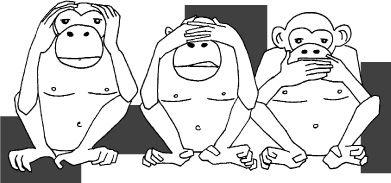The Definitive Book of Body Language (23 page)
Read The Definitive Book of Body Language Online
Authors: Barbara Pease,Allan Pease


“She always nags me!”
The thumbs have been used as a sign of power and authority for thousands of years. In Roman times, the thumb held up or down meant life or death to a gladiator. Even without any training, others intuitively decode thumb signals and seem to understand their meaning. You are now in a position not only to decode thumb signs, but to train yourself to use them.
EVALUATION AND
DECEIT SIGNALS

Bill Clinton in front of the grand jury—
what do you think he's thinking?
If you told the absolute truth to everyone you interacted with, what would be the result? If you said the
exact words
going through your mind as you thought them, what consequences would it bring? For example:
To your boss:
“Good morning, boss—you talentless slob.”Man to a female customer:
“Thanks for your business, Susan, and may I say what wonderful firm breasts you have.”Woman to a male neighbor:
“Thanks for helping me with my groceries. You've got a nice tight butt, but who the hell cuts your hair?”To your mother-in-law:
“It's nice to see you again—you interfering, negative old bat.”
When a woman asks, “Does this dress make me look fat?” what is your answer? If you are a man, and you know what's good for you, you'd say she looked good. But you might have been thinking,
“The dress doesn't make you look fat—it's all the cake and ice cream you eat that makes you look fat.”
If you told everyone the complete truth all the time, you'd not only end up lonely, you might even end up in a hospital or prison. Lying is the oil that greases our interactions with others and lets us maintain friendly social relationships. These are called
White Lies
because their goal is to make others feel comfortable instead of telling them the cold, hard truth. Research shows that social liars are more popular than those who continually tell the truth, even though we know the social liar is lying to us.
Malicious Lies
, however, are where one person deliberately sets out to deceive another for personal benefit.
The least dependable signs of lying are the ones over which a person has the most control, such as words, because a person can rehearse their lies. The most reliable clues to lying are the gestures a person makes automatically, because they have little or no control over them. These responses are most likely to happen during lies because they are emotionally the most important things to the liar.
Robert Feldman at the University of Massachusetts in Amherst studied 121 couples as they had a conversation with a third person. One third of the participants were told to appear likeable, while another third were instructed to seem competent, and the rest were asked just to be themselves. All participants were then asked to watch the video of themselves and identify any lies they had told during the conversation, no matter how big or small. Some lies were white lies, such as saying they liked someone when they really didn't, while other lies were more extreme, such as falsely claiming to be the star of a rock band. Overall, Feldman found that 62 percent of his participants told an average of two to three lies every ten minutes. James Patterson, author of
The Day America Told the Truth
, interviewed over two thousand Americans and found that 91 percent lied regularly both at home and at work.
“It is always the best policy to speak the truth
,
unless of course you are an exceptionally good liar.”
J. K. JEROME
So how can you tell when someone is lying, stalling, or simply thinking it over? Recognition of deceit, procrastination, boredom, and evaluation gestures can be some of the most important observation skills you can learn. In this chapter, you'll learn the body-language signals that give people away The first part of the chapter will deal with lying and deceit.
These monkeys symbolize those who hear no evil, see no evil, and speak no evil. Their simple hand-to-face gestures form the basis of the human deceit gestures. In simple terms, when we see, speak, and hear lies or deceit, we are likely to attempt to cover our mouth, eyes, or ears with our hands.

Hear no evil, see no evil, speak no evil
People who hear bad news or witness a horrific accident will often cover their entire face with their hands to symbolically stop themselves from seeing or hearing the awful news. This was the gesture that was most observed worldwide when people
heard about the planes flying into the Twin Towers on September 11, 2001.
As we've already discussed, children often use hand-to-face gestures openly when they lie. If a child tells a lie, he will often cover his mouth with one or both hands in an attempt to stop the deceitful words from coming out. If he doesn't want to listen to a reprimanding parent, he simply covers his ears with his hands to block out the noise. When he sees something he doesn't want to look at, he covers his eyes with his hands or arms. As he becomes older, these hand-to-face gestures become quicker and less obvious, but they still occur when he is lying, covering up, or witnessing deceit.
These gestures are also associated with doubt, uncertainty, or exaggeration. Desmond Morris conducted research in which nurses were instructed to lie to their patients about their health in a role-play situation. The nurses who lied showed a greater frequency of hand-to-face gestures than those who told the truth to the patients. Men and women also both increase their number of gulps of saliva when lying, but this is usually noticeable only with men, as they have an enlarged Adam's apple.
“I did not have sexual relations with that woman,”
said the politician as he gulped and rubbed his nose.
As mentioned at the beginning of this book, we'll be analyzing gestures in isolation and discussing them individually, but this is not how they usually occur. They are part of a larger gesture cluster and should be studied in the same way as words in a sentence, that is, how each word is relevant to other words and the overall context in which they are used. When someone uses a hand-to-face gesture, it doesn't always mean that he or she is lying. It does indicate, however, that the person could be holding back information and further observation of other gesture clusters can confirm or deny your suspicions. It's important that you avoid interpreting a single hand-to-face gesture in isolation.
While there is no single guaranteed movement, facial expression, or twitch that confirms someone is telling a lie, there are several clusters you can learn to recognize that will dramatically increase your chances of spotting a lie.
The face is used more than any other part of the body to cover up lies. We use smiles, nods, and winks in an attempt to cover up, but unfortunately for us, our body signals will tell the truth when there is a lack of congruence between our body gestures and facial signals. Our attitudes and emotions are continually revealed on our faces and we are completely unaware of it most of the time.
Fleeting incongruencies in the face
reveal conflicts in the emotions.
When we're going to try to conceal a lie, or a certain thought flashes into our mind, it can be shown for a split second on our face. We usually interpret someone's quick nose touch as an itch, or that when they rest their hand on their face they are deeply interested in us, without ever suspecting that we're boring them to death. For example, we filmed a man discussing how well he got on with his mother-in-law. Each time he mentioned her name the left side of his face rose in a momentary sneer that lasted only a split second but told us volumes about how he really felt.
In
Why Men Lie and Women Cry
(Orion) we showed how women are better at reading emotions, and therefore better at manipulating others with an appropriate lie. This trait is seen
in baby girls who cry in sympathy with other babies and can then cause other babies to cry by simply bursting into tears at will. Sanjida O'Connell, PhD, author of
Mindreading
, conducted a five-month study into how we lie and also concluded that women are far better liars than men. She found that women tell more complicated lies than men, whereas men tell simple lies such as “I missed the bus” or “My cell-phone battery was dead—that's why I couldn't call you.” She also found that attractive people are more believed than unattractive ones, explaining why leaders such as John F. Kennedy and Bill Clinton were able to get away with as much as they did.
As we said in Chapter 3, most people believe that when someone is lying they smile more than usual, but research shows the opposite is true—they smile less. The difficulty with lying is that the subconscious mind acts automatically and independently of our verbal lie, so our body language gives us away. This is why people who rarely tell lies are easily caught, regardless of how convincing they may sound. The moment they begin to lie, their body sends out contradictory signals, and these give us a feeling that they're not telling the truth. During the lie, the subconscious mind sends out nervous energy, which appears as a gesture that can contradict what was said. Professional liars, such as politicians, lawyers, actors, and television announcers, have refined their body gestures to the point where it is difficult to “see” the lie, and people fall for it, hook, line, and sinker.
They do it in one of two ways. First, they practice what “feel” like the right gestures when they tell the lie, but this only works when they have practiced telling a lot of lies over long periods of time. Second, they can reduce their gesturing so that they don't use any positive or negative gestures while lying, but that's also hard to do.
With practice, liars can become
convincing, just like actors.
Try this simple test—tell a deliberate lie to someone face-to-face and make a conscious effort to suppress all body gestures. Even when your major body gestures are consciously suppressed, numerous small microgestures will still be transmitted. These include facial muscular twitching, dilation and contraction of pupils, sweating, flushed cheeks, eye-blinking rate increasing from ten blinks per minute to as many as fifty blinks per minute, and many other microsignals that indicate deceit. Research using slow-motion cameras shows that these microgestures can occur within a split second and it's only people such as professional interviewers, salespeople, and the very perceptive who can read them.
It's obvious, then, that to be able to lie successfully, you need to have your body hidden or out of sight. Interrogation involves placing the person on a chair in the open or placing him under lights with his body in full view of the interrogators; his lies are much easier to see under those circumstances. Lying is easier if you're sitting behind a desk where your body is partially hidden, peering over a fence, or from behind a closed door. The best way to lie is over the telephone or in an e-mail.